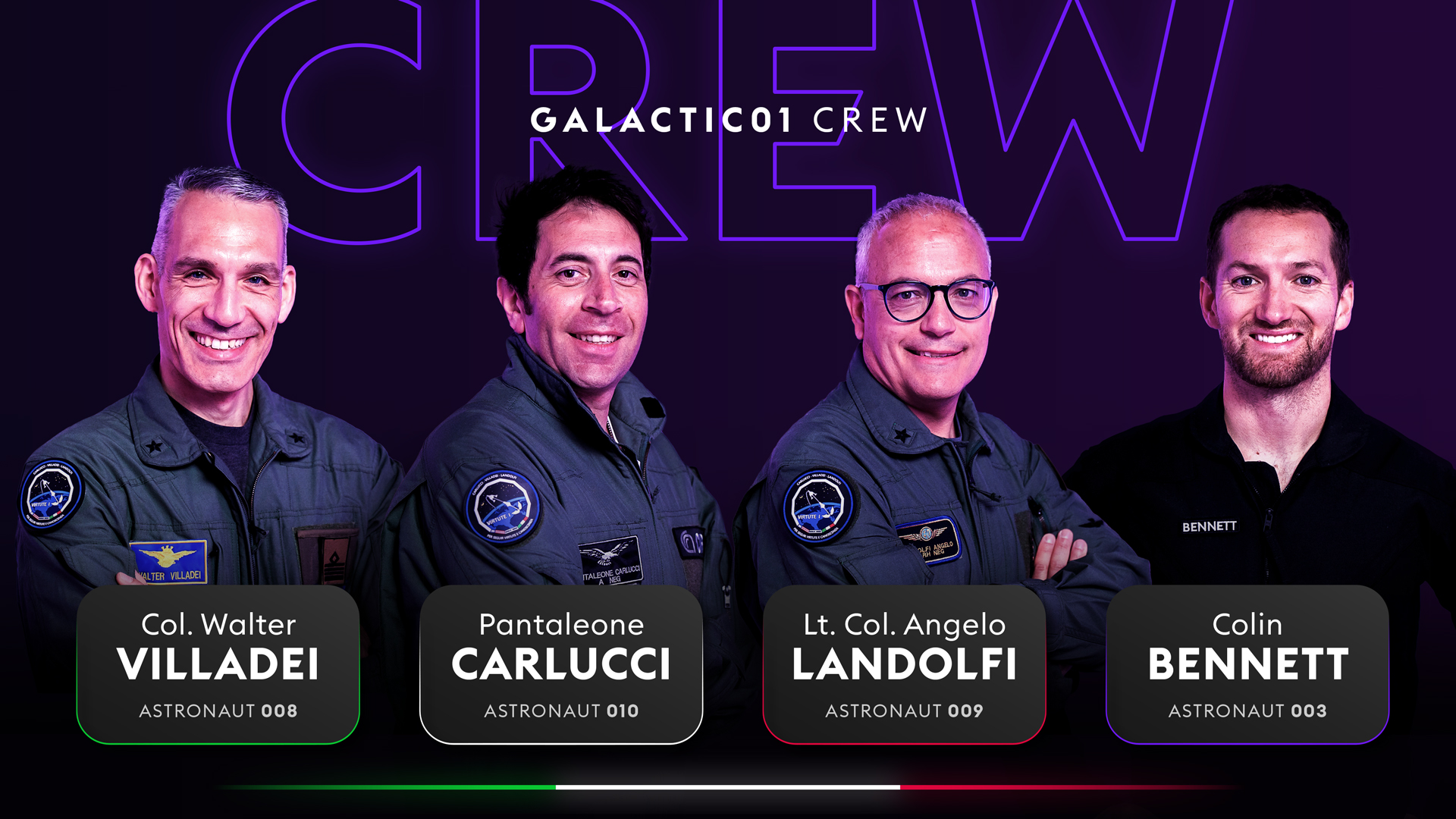Update for 12:20 p.m. ET, June 29: Virgin Galactic's SpaceShipTwo space plane, VSS Unity has successfully landed, completing the company's first commercial spaceflight. See more images, video and read our full wrap story.
Virgin Galactic is ready for the crucial first fully commercial flight of its SpaceShipTwo space plane.
The mission, known as Galactic 01, will fly from Spaceport America in New Mexico on Thursday (June 29), carrying four passengers and 13 experiments for collecting medical and cosmic radiation data and studying fluid dynamics. Liftoff is expected sometime after 11:00 a.m. EDT (1500 GMT); you can watch the action live here at Space.com, courtesy of Virgin Galactic.
Two pilots will guide the mothership VMS Eve to an altitude of 50,000 feet (15,000 meters), before the SpaceShipTwo vehicle VSS Unity separates and ignites its rocket engines for the climb to suborbital space. Aboard Unity will be another pair of pilots, Nicola Pecile and Mike Masucci, along with three passengers from the Italian Air Force and National Research Council (of Italy) who will conduct and oversee the experiments. A fourth passenger, Virgin Galactic astronaut instructor Colin Bennett, will fly with the trio to help with such work.
The flight is also a major moment for Virgin Galactic's plans for future flights. "Virgin Galactic's research missions will usher in a new era of repeatable and reliable access to space for government and research institutions for years to come," said Virgin Galactic CEO Michael Colglazier in a statement.
The mission also aims to demonstrate SpaceShipTwo's microgravity research capabilities, another source of potential revenue alongside private tourist spaceflight services.
"This flight will showcase our distinctive spaceflight system, which allows researchers to fly with their experiments, and our capacity to offer regular access to space for the science and technology community," said Sirisha Bandla, vice president of government affairs and research operations at Virgin Galactic, in a statement.

Beyond the details and aims of the mission, the flight is widely seen as a big moment for the company.
"Despite delays, this is a significant milestone for the company and might open up a new era for suborbital flight," Matija Rencelj, research manager at the European Space Policy Institute in Vienna, told Space.com.
The flight will also be crucial for Virgin Galactic's expansive future plans. A flawless flight is needed to ensure a quick turnaround, which the company is shooting for. The second flight of Virgin Galactic's commercial spaceflight services, named Galactic 02 and tailored to private astronauts, is scheduled for early August.
Full success can't be taken for granted, of course. The company's first fully crewed mission, carrying Virgin Group founder Richard Branson and several other passengers in July 2021, veered off its approved flight envelope due to a failure to take into account strong high-altitude winds. SpaceShipTwo was grounded while the U.S. Federal Aviation Administration (FAA) conducted an investigation into the incident. The company performed its next test flight on May 25, nearly two years later. (Virgin Galactic also took time during this stretch to maintain and upgrade both Eve and Unity.)
If all goes well with Galactic 01 and 02, Virgin Galactic aims to conduct monthly spaceflights. Keeping up this rate of activity will be key to generating and maintaining interest as well as revenues, with flights selling at $450,000 per seat.
This monthly cadence, however, still may not be enough to make the company's plans sustainable. At the moment, VMS Eve and VSS Unity are Virgin Galactic's only carrier aircraft and spacecraft, respectively.
"What will be more important for the economic viability of Virgin Galactic's business is the ability to sustain a high cadence of flights and spark recurrent interest of passengers," said Rencelj, who noted that the company accrued significant losses in recent years, including $500 million in 2022.
The company also recently raised $300 million and is seeking to raise a further $400 million in order to develop and expand its spacecraft fleet, CNBC reported on June 22.
Rencelj said that Virgin Galactic customer deposits are indicated in the range of $100 million, meaning the company is "betting big on future revenues once commercial spaceflight operations commence."
"It will be interesting to see how the pricing and product evolve, and whether first reactions of paying customers can catalyze further interest. The company will need a strong demand push," Rencelj said.
There is also the backdrop of recent events in other extreme environments. The flight is taking place against the backdrop of the Titan sub tragedy, in which the catastrophic implosion of an uncertified tourist submersible claimed the lives of five people.
A tragedy high above Earth would likely have serious implications not just for Virgin Galactic, but for the nascent private spaceflight industry as a whole.
"It is exactly the kind of scenario that would trigger a big discussion if it were to happen in a space tourism flight," Tommaso Sgobba, executive director of the International Association of the Advancement of Space Safety (IAASS), recently told Space.com.







